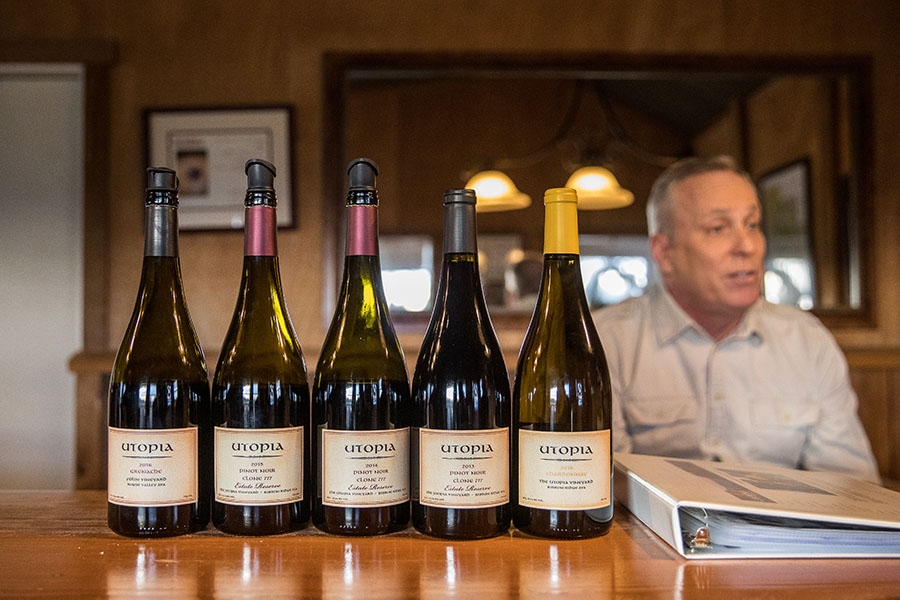Sales plummet at the state’s small vineyards that rely on tasting-room visits to generate income.
Before the pandemic brought business to a standstill, Oregon wineries had enjoyed five years of solid growth. Tasting-room visits had more than doubled over that period. Between 24 and 44 new wineries were opening in the state every year, according to the Oregon Wine Board.
Within a matter of days in March, that growth came to a halt as Gov. Kate Brown’s ban on social gatherings forced wineries to close tasting rooms, where most sell the bulk of their wine.
This direct-to-consumer sales model has left Oregon’s wineries scrambling to boost online sales and find creative ways to market themselves through virtual tasting-room visits.
RELATED STORY: State of Grapes
Unlike many of the larger wineries in Washington and California, few of the small wineries in Oregon sell wines in grocery stores through a distributor. Their proximity to Portland means they have been able to rely on a steady stream of visitors, whom they sell wines to directly from their tasting rooms.
Steve Lutz, winemaker at Lenné, a winery in the Willamette Valley, is offering discounts for online sales and virtual tastings. He now depends on generating revenue through his wine club, which has 700 members. Although there have been a few members canceling orders, the club is “what is sustaining us,” says Lutz.
He has been surprised with the success of virtual tastings. In these tastings, customers buy wines online and when they arrive, they can watch a video in which winery staff taste and discuss the wines. “People are hungry for connection,” he says. “Wineries are like a favorite restaurant — people are connected to them. Virtual tastings help you keep that connection.”
He has had so much success with virtual tastings that he plans to keep doing them after reopening. “I thought, we should have been doing this for our out-of-state customers,” says Lutz.
The winery’s direct-to-consumer sales model means the business has lost out to increased sales of wine from grocery stores, which is where consumers are mostly buying wine from since the closure of restaurants. But selling through a distributor would be a “last resort” for the business, says Lutz. “We are not a grocery-store brand. People tend to drink lower-priced products [from stores]. It doesn’t fit our business model.”
This sentiment is echoed by Dan Warnshuis, owner of Utopia. His business also relies on selling direct to consumers, and as a result, he has seen a drop in sales. He also does not want to sell in grocery stores because it would “dilute [his] brand.”
He feels selling at a discount in stores would mean he would lose tasting-room customers who would be put off from buying the higher-priced wine direct from the winery.
For now, he is relying on sales from his wine club. Because members have disposable income — his wines sell for around $50 a bottle — his customers tend to be more insulated from recessions than average consumers. The ultra-premium wine sector, for example, performed well during the 2008 financial crisis.
But the longer the recession lasts, the harder it will be for all wineries relying on direct-to-consumer business models. Another worry for Warnshuis is maintaining the cultivation of grapes on his vineyard. He would normally hire a dozen laborers, but he stopped because he was worried about virus transmission. “It is tough. I am now using my family to do the farm work,” he says.
Larger, more diverse wineries have a bit more leeway during the crisis. David Nemarnik, owner of Alloro Vineyard, sells wine direct to consumer through tasting rooms as well as in grocery stores. He has not seen a big uptick in store sales during the pandemic, but he is expecting sales to increase as the crisis continues.
The closure of his tasting room has led him to be “more thoughtful about online [sales].” At this time of year, he would usually sell most wines. May is peak season for tasting-room visits. The winery is offering drive-through service in which customers pick up wine directly from his business. His proximity to Portland means pick-ups are more viable than for the more remote wineries.
He is also offering customers boxes of produce that include fruit or vegetables paired with bottles of wine. The fresh produce is supplied by his other business, Pacific Coast Fruit Company, a fruit and vegetable distributor to restaurants.
Nemarnik says if he reaches 80% of projected sales in 2020, he will have had a “solid” year. “It all depends on how things get back to normal,” he says.
Small direct-to-consumer wineries that hope to generate new sales by going through a distributor may find it difficult to make inroads into that model. Shaun Dobbelaere, chief operating officer of Vehrs Distributing, says he has seen a couple of wineries approach him about selling in stores, but he is only interested in establishing long-term partnerships with new suppliers that will last beyond the duration of the pandemic, he says.
He adds grocery stores are reluctant to stock new products because they are still “scrambling just to stock shelves.” Vehrs Distributing lost business selling to restaurants as a result of the shutdown. Some restaurants in the past few weeks have started selling wine as part of food-takeout service. But on-premise restaurant sales are still down 90%.
Retail wine sales are strong and steady, says Dobbelaere. The panic buying that stores experienced in the first few weeks of the shutdown has now subsided, and grocery-store wine sales are on par with this time last year, he says.
As the lockdown continues, small wineries rely on wine-club members to keep them in business. For Lutz at Lenné, club sales are his lifeline. If he lost half his members, he could make it to next year, he says. But if all members canceled, he “probably wouldn’t make it past September.”





